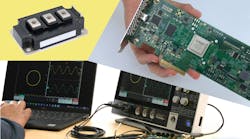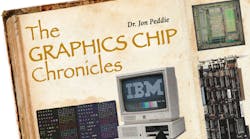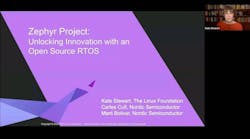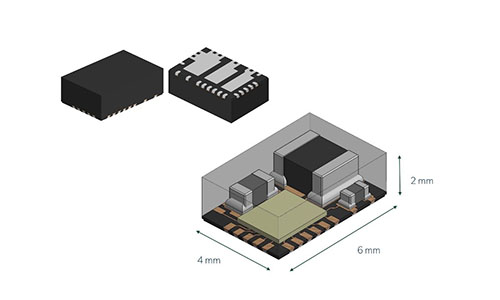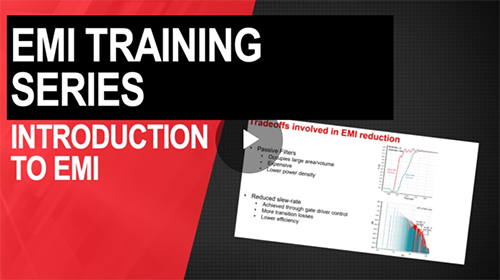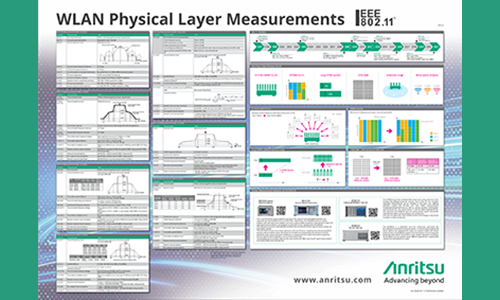This article is part of theTechXchange:研究EMI,EMC和噪音
您将学到什么:
- 什么是mgig?
- Why is EMI such a threat to mGig transceivers?
- The three algorithms that can help mitigate EMI.
In the past, enterprise networks used 1000BASE-T Ethernet at the access layer for 1 Gb/s connectivity. But the advent of Wi-Fi 6 (IEEE 802.11ax) wireless access points has triggered a dire need for faster uplink rates between those access points and wiring closet switches. Other data-intensive use cases for enterprise campuses, university research, medical imaging, CAD/CAM, and media editing also require networking rates faster than 1 Gb/s.
As a result, the IEEE specified a new transceiver technology under the auspices of the 802.3bz standard, which addresses these needs. The industry adopted the nickname “mGig,” or multi-Gigabit, to designate those physical-layer (PHY) devices that conform to 802.3bz (capable of 2.5 Gb/s and 5 Gb/s) and 802.3an (10 Gb/s).
In addition to the Wi-Fi 6 dynamic, the pandemic has highlighted the need for more robust data rates to residential environments (for stay-at-home workers). Next-generation Internet Access systems such as 5G fixed wireless and 10G PON can satisfy those demands. But customer premises equipment (CPE) for these systems requires mGig technology to fully utilize the greater-than-1-Gb/s data rates offered by these new residential connectivity solutions.
The proliferation of mGig transceivers, which provide Ethernet connectivity with data rates beyond 1 Gb/s over unshielded copper wires, has brought with it a new danger: interference from radio-frequency emitters that can distort and degrade data-transmission fidelity. Why? Because unshielded cable acts as a giant antenna, picking up all sorts of stray electromagnetic interference (EMI).
The electronics industry has come up with several sophisticated digital-signal-processing (DSP) algorithms to contend with this problem. This article examines the most popular ones, how they work, and weighs which algorithms are better than the others.
EMI缓解措施 - 为什么?
Enterprise Ethernet cables are typically Cat5e or Cat6 cables that contain four twisted-wire pairs encapsulated by plastic cladding. Higher-grade cables found in enterprise data centers, so-called Cat6a cables, are specified to higher bandwidth but are essentially similar in construction.
所有这些电缆类型的关键特征是它们没有屏蔽,因此很容易受到各种RF发射器的EMI的影响。结构化的接线规则允许安装多达100米电缆的长度。而且,确实,指定了符合IEEE的以太网收发器来支持此类长度。但是,这种不屏蔽的电缆的长曲子基本上形成了一种天线状结构,从而吸收了RF能量。
Pick-up of these interfering signals causes bit errors in Ethernet transmission and results in errored Ethernet packets. Some protocols are tolerant of such packet errors, as higher layers of the communications stack can detect and retransmit errored packets. But for many more modern applications, such as video or audio transmission, clock distribution, or preemptive packets with a high QoS priority, there’s no time to retransmit errored packets—and the result is more noticeable and potentially catastrophic.
One piece of good news is that many common RF emitters, such as cellular telephones, Bluetooth transmitters, Wi-Fi routers, and microwave ovens, emit frequencies that are in the 2- to 5-GHz range. Therefore, they fall outside of the mGig band of interest (0 to 400 MHz). But some RF emitters transmit directly in that band. Emitters such as FRS radios (walkie-talkies), AM and FM radio, TV, amateur-band (ham) radios, and police and taxicab radios are but a few examples.
一个特别阴险的财产的射频emitters is that they can reside in mobile platforms, so their impact can be intermittent and hard to diagnose. A police car drives by, creates havoc with the network, and then leaves the IT manager to figure out what the heck happened.
Testing for EMI Susceptibility
风险识别的EMI能释放on Ethernet networks, the electronics industry has come up with a few documented, standardized tests that Ethernet networking equipment can be measured against to quantify their EMI susceptibility. The relevant EMI tests are:
- Telcordia GR1089
- IEC 61000-4-3 CISPR 24 for Radiated Susceptibility
- IEC 61000-4-6 CISPR 24 for Conducted Susceptibility
辐射敏感性测试是在EMI测试室中进行的(Fig. 1),将设备放置在没有外部干扰器的环境中,并在关注的频段中传输并扫除了校准的RF能量。毫无疑问,在这样的室内进行测试是“黄金标准”,并提供了以最佳方式模仿现实生活条件的结果。
However, gaining access to such a chamber can be cumbersome and pricey. For that reason, engineers have developed alternative equipment that can be used on a lab bench. Such equipment is typically realized with a clamping arrangement in which a length of unshielded cable is placed in an enclosure (clamp) and radiated with RF energy. The cable also is connected to a set of Ethernet transceivers. The test measures any disturbance the RF energy causes to data flow, usually by measuring the number of lost packets observed during the test.
Because such clamps have trouble emulating the full spectrum of frequencies possible in the EMI chamber, testing has been divided into two types depending on the frequency band. Type 1, for low frequencies, is called Conducted Susceptibility (CS) testing and is typically implemented with a so-called coupling/decoupling network, or CDN(Fig. 2). Type 2 uses a cable clamp for equivalent radiated susceptibility (RS) testing(Fig. 3).
Field strengths between 3 and 10 V/m are typically used in EMI test chambers. However, tests up to 6 V/m are sufficient for the lab-bench tests due to the proximity of the RF emitter to the cable under test.
EMI缓解算法
To contend with the problem of narrowband electromagnetic interference in Ethernet transmission systems employing unshielded twisted-pair cable, three types of EMI mitigation algorithms have been developed. These are typically implemented inside of the Ethernet transceiver silicon by using the device DSP engine.
这些算法中的第一种由IEEE在802.3AZ工作组的主持下标准化,称为“快速再培训”。在此方案中,链接合作伙伴接收器负责识别RF干扰器。然后,它将干涉频率信息发送到链接另一侧的发射器。反过来,发射器又将凹口滤波器放在发射路径中,从而消除了由干扰源主导的频带中的传输。可以同时放置几个这样的缺口过滤器,以与多种RF源抗衡。该算法的响应时间在30毫秒范围内。
Cisco Systems also created a similar algorithm it calls “Negotiated Fast Retrain,” and it’s published in the company’s ENG-977716 bulletin. The algorithm works on the same principles described for the IEEE standardized Fast Retrain scheme, but it has a response time between 30 and 200 ms depending on the link partner.
A third type of EMI mitigation system is called Common Mode Sense (CMS). The interesting property of this algorithm is that it only relies on the receiver electronics and doesn’t necessarily require cooperation with the link partner.
In the CMS scheme, the interfering signal, which is presented as a common-mode voltage on the link, is digitized, with a dedicated analog-to-digital converter (ADC) inside the transceiver silicon. Then it’s arithmetically subtracted from the incoming Ethernet signal using the transceiver’s DSP engine. Because this system doesn’t require communication between the two ends of the link, response times are relatively fast—on the order of 10 µs.
这些算法如何堆叠?
Comparing the effectiveness of these algorithms results in a predictable conclusion: Response speed is critical to maintaining a low packet-loss rate. That’s because during the time the transceiver is reacting to the onset of interferer energy, bit errors in the transmission occur and packets are lost.Figure 4通过提供快速再培训和CMS系统之间的测量数据来说明这一概念。在这里,我们看到CMS算法的利用率导致数据包损失率在3和10-V/m场强度下的数量级好几个数量级。
Note that the utilization of the CMS algorithm doesn’t preclude the use of the Fast Retrain algorithm as well. In fact, the CMS scheme is so fast, it can react during the time the Fast Retrain algorithm is being set up. And, in reality, modern implementations use both to enhance the device robustness to EMI.
Another method for comparing the effectiveness of CMS with other EMI mitigation algorithms involves laboratory measurements of transceiver devices that employ the CMS algorithm versus those that don’t use it.
Figure 5描述了这种对辐射易感性等效与电缆夹相等的测试的结果(称为RS-CC)。在这里,使用CISPR 24使用IEC 61000-4-3等效测试。该测试以1%步长以1%的步骤进行扫描,每个频率为1秒。显示了1至6 V/m的等效RS测试水平。如所见,一个马尔维尔10GBase-T transceiver with CMS tolerates 6X larger field strengths than one without CMS for equivalent packet loss.
One might suspect that such results are pronounced because the data rate utilized—10 Gb/s—is quite high for a copper-based system. And the fact that lower data rates would, perhaps, demonstrate less dramatic results. However, that theory isn’t borne out with experimental data. As seen inFigure 6, data rates of 5 Gb/s and 2.5 Gb/s offer similarly impressive disparities between CMS and non-CMS transceivers.
Conclusion
MGIG收发器填补了使用现有未屏蔽的扭曲铜线电缆的高速网络的增长要求。然而,它们对更宽的带宽和固有的噪声灵敏度的利用增加了其对电磁发射器干扰的敏感性。基于DSP的缓解算法,尤其是通用模式感知算法,提供了一种有效的技术来缓解这种敏感性。它们允许在当今的现代企业,数据中心和访问网络中进行无错误的传输。
Read more articles like this at theTechXchange:研究EMI,EMC和噪音









